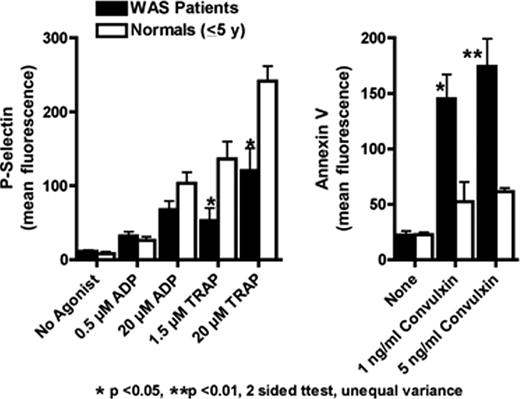Abstract
Abstract 1429
Wiskott-Aldrich syndrome (WAS) is a complex disease in which patients suffer from both bleeding and immunodeficiency. Thrombocytopenia is severe, platelets are small and may be dysfunctional; intracranial hemorrhage occurs in 20% of patients. In patients with the full WAS phenotype, early use of human stem cell transplantation (HSCT) corrects the immune deficiency and thrombocytopenia although platelet transfusions are often required. Bleeding is the main complication of the X-linked thrombocytopenia (XLT) form, whose management may include HSCT, splenectomy, or supportive care; IVIG has limited benefit. Platelet function in WAS/XLT patients with low platelet counts has not been reported because of the inability to accurately perform standard assays in severely thrombocytopenic patients. The present study evaluated platelet function and thrombopoietin (TPO) mimetic (romiplostim or eltrombopag) treatment of thrombocytopenia in patients with WAS/XLT.
Flow cytometry, which enables evaluation of platelet function despite thrombocytopenia, was used to study platelets in 8 WAS/XLT patients and age-matched normal controls. Platelet function was measured by: surface expression of P-selectin and activated GPIIb-IIIa (reported by PAC1) in whole blood following stimulation with low and high dose ADP and thrombin receptor activating peptide (TRAP); annexin V binding, a marker of platelet surface expression of the procoagulant phospholipid phosphatidylserine, in platelet-rich plasma (normalized to 30,000 platelets/μL) following stimulation with convulxin (a specific agonist of the platelet collagen receptor GPVI). The effects of romiplostim (10 μg/kg/wk SQ) or eltrombopag (50-75 mg/day PO) on platelet counts and bleeding were evaluated in 4 patients (3 WAS, 1 XLT).
Platelets from WAS/XLT patients showed reduced TRAP-induced platelet surface P-selectin and activated GPIIb-IIIa (p <0.05) compared to age-matched control children (Figure). In contrast, convulxin-induced annexin V binding to platelets was greater than normal controls (p <0.05). These findings were observed in both WAS and XLT platelets and in non-splenectomized (6) and splenectomized (2) patients. As expected, platelet size of WAS/XLT platelets, as judged by forward light scatter, was smaller than that of normal controls. Two infants were treated with romiplostim and 2 older patients were treated with eltrombopag. One infant had 2 intervals of approximately 1 month each in which his platelets were supported entirely by romiplostim and maintained >20-30,000/μL. However, at times of infection with prolonged antibiotics, romiplostim was insufficient although it enabled platelet transfusions to be given weekly. In the other infant, who had both WAS-associated and autoimmune thrombocytopenia, romiplostim had no apparent effect; his platelets were only responsive to the combination of IVIG/methylprednisolone plus platelet transfusion given 2–3 times weekly prior to HSCT. A 25 year old XLT patient received eltrombopag for 4 weeks with a platelet increase from 18 to 33,000/μL. A fourth patient, with WAS, who had failed HSCT was treated with eltrombopag without consistent success. In the first infant on romiplostim and the XLT patient on eltrombopag, clinical bleeding was reduced in conjunction with the increased platelet count.
Bleeding in WAS/XLT may be the result of both platelet dysfunction and thrombocytopenia. WAS/XLT platelets are smaller and express less surface P-selectin and less activated GPIIb-IIIa in response to TRAP stimulation than age-matched controls. However, WAS/XLT platelets, when stimulated via the collagen receptor GPVI, express more phosphatidylserine, which supports formation of the prothrombinase complex, than control platelets. The reduced platelet function in WAS/XLT patients resulting from reduced platelet number, size, and surface P-selectin and activated GPIIb-IIIa may be counterbalanced in part by increased GPVI-mediated procoagulant activity. However, increased platelet procoagulant activity may shorten platelet lifespan, contributing to the thrombocytopenia in WAS/XLT. Platelet counts were increased and clinical bleeding was decreased in 2 of 4 WAS/XLT patients treated with TPO mimetics. The possible use of TPO mimetics to increase platelet count and/or function in WAS/XLT patients merits further study.
Bussel:Portola: Consultancy; Eisai: Consultancy, Membership on an entity's Board of Directors or advisory committees, Research Funding; GlaxoSmithKline: Consultancy, Equity Ownership, Research Funding, Speakers Bureau; Amgen Inc.: Equity Ownership, Research Funding, Speakers Bureau; Cangene: Research Funding; Genzyme: Research Funding; Immunomedics: Research Funding; Ligand: Research Funding, Speakers Bureau; Shionogi: Research Funding, Speakers Bureau; Sysmex: Research Funding. Off Label Use: romiplostim and eltrombopag; increase platelet counts in Wiskott-Aldrich syndrome/X-linked thrombocytopenia patients. Michelson:GlaxoSmithKline: Honoraria.
Author notes
Asterisk with author names denotes non-ASH members.


This feature is available to Subscribers Only
Sign In or Create an Account Close Modal